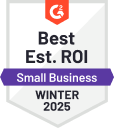9 simple tips on how to make cold calling far less stressful in 2025

Overwhelmed and frightened by having to make cold calls? You’re not alone. To take some stress off your shoulders, we’ve collected 9 simple tips to make cold calling a little bit easier.
Cold calling is the bane of existence both for consumers and companies. Do you hate cold calls as well? Do you see it as a method that requires far too much effort for such poor results? And is it far too stressful?
If you yes to any, or all, of the above questions, then I’m pretty sure you are not alone. ValueSelling Associates and Selling Power research says that 48% of sales reps are afraid to pick up the phone and make cold calls. The reason? In 2007, it took an average of 3 cold call attempts to reach a potential buyer.
In 2014, According to TopHQ the situation got much worse still, and it now takes 18 calls to actually connect with a buyer. I am not really surprised, though, considering how many people see cold calling as a nuisance.
Key takeaways:
- Transform cold calls into assets by prioritizing pre-call research, using a well-crafted script, identifying optimal call times, mastering objection handling, and fostering engaging dialogues.
- Modernize cold calling with our 9 tips, emphasizing thorough pre-call research, a comprehensive script, strategic timing, objection handling, and the use of automation tools like CloudTalk.
- Cold calling demands persistence. Multiple attempts increase success rates. Embrace CRM tools and virtual call center systems that are automating follow-ups and lead scoring. Enhance efficiency and reduce frustration.
Scale Fast And Efficiently
And with the number of other available means to reach potential customers, like cold emails or social media, shouldn’t calling a prospect who has not previously expressed any interest in your products or service be deader than disco?
Well, if you consider cold calling to mean phoning hundreds of random people with the hopes that someone will be interested in your product, then you’d be right that it doesn’t work anymore. But with a few tweaks to the old cold calling approach, many companies are finding to their surprise, that this method is still working well. 41% of respondents to Marc’s Wayshak study said that phone calls are actually their best sales tool! How is that possible?
Well, a lot of cold callers still use those ancient “spray and pray” strategies. If out of a dozen calls, they get one interested person, that’s a success for them. Don’t sell yourself short that way! If you adapt your cold calling strategy to modern times, you can get much more done in a shorter time and with far less frustration than now. How? Here are our nine tips on how to change cold calling from a daily chore to a vital asset in your company!
Nine cold calling tips for 2025
#1 Carry out pre-call research
We’re all familiar with those salespeople who call out of nowhere with a “fantastic offer”. Too bad it’s not at all what the consumer wants. Or maybe the client is interested in the offer but later learns they’re not actually eligible for it. Case in point: some months ago, I answered a cold call about a Fibre internet plan offer. Unfortunately, the moment I declared my interest, it turned out that there was no optical fiber cable in my neighborhood! Awkward, isn’t it?
You can avoid such embarrassing situations by:
- carrying out thorough research on your prospects before calling them
- knowing essential information about your consumers will help you customize offers to their needs and also help you to maintain their attention without wasting your own time and energy on hopeless leads
#2 Write a cold calling script
Making several cold calls a day and talking with different people is no easy task. And it’s even harder (and more stressful) if you are a newbie and just started to learn the ropes. Having a call script with all of the necessary information, plus offering details and tips about how to deal with demanding or rude customers, would be incredibly helpful for both your new sales reps and experienced ones.
It would give them…
- a clear list of steps to take during cold calls
- detailed answers to frequently asked questions
- advice about facing sales objections
In case your sales reps get distracted, a cold calling script will help them get back on track.
Of course, a script isn’t there for your sales reps to read word for word. If a consumer thinks that they are listening to a pre-recorded message because of how robotic the call sounds, they will hang up. Treat it more as a helpful checklist of what should be mentioned during each call.
Don’t fear changing the script based on what does (and doesn’t) work during the calls either!
#3 Find a good time to call
One of the main reasons people react with an annoyed groan to a cold call is awful timing. A sales pitch on Friday at noon? Or maybe a call on Monday morning?
Plenty of salespeople seem to prefer phoning in the early morning for some reason. Perhaps they think it’s better to call prospects before they start work and become too busy? But really, the last thing people tend to think about in the early morning is a new sales offer. You need to find a better time to call.
A good tip here is to analyze the call records you have in order to find out what days and times people most often answer the phone. Scheduling your calls to that time of the day might be just what you need to improve your sales performance.
#4 Learn how to deal with objections and rejections
Hearing a yes on a first sales call was possible several years ago, but nowadays, the vast majority of customers will have their objections and doubts. But dealing successfully with sales objections might be just what seals a deal.
It’s especially worthwhile to learn how to answer the most common sales objections, such as:
- “it’s too expensive”
- “I don’t need this product right now”
- “I’m already using something similar”
To help your sales reps overcome such obstacles, it’s a good idea to include guidance about how to deal with specific objections or doubts in your sales script.
Another issue that your sales reps must be familiar with is dealing with rejection. Try as they might, reps won’t be able to close every deal, so it’s crucial for them to learn how to take a “no” in their stride and move on to another prospect. ortant insights, helping you refine scripts and shorten call handling times.
Start calling with a complimentary virtual phone number for 14 days free!
#5 Don’t start cold calls with a sales pitch
A lot of sales reps make this mistake. They start the call by immediately presenting their offer without even asking for the opinion of the person on the other end of the phone. And if there is something that the consumer is looking for, reps often dive straight into selling their product or service. They might get lucky, and their solution might be exactly what the recipient needs at the given time, but is a sales rep’s job really about “being lucky”?
If you called me and started immediately talking about how excellent your product is without letting me say a word, I’ll just politely thank you and end the call.
However, if you…
- took your time to ask me what I need
- tailored the offer you are calling with to my needs
- and than started a sales pitch
…it’s an entirely different story!
If you want your prospect to stay on the line, start by gauging their needs and expectations, or risk them ending the call before you even manage to finish the pitch.
#6 Calls are a dialogue, not a monologue
Sales reps who start immediately with a sales pitch also often make another mistake, which is that they talk endlessly. The prospect may try, but they simply aren’t allowed to say a word unless it happens to be “yes.” It’s like such reps think that the longer they talk, the more convinced the client will be. Quite the opposite is true in reality.
If you don’t give your clients enough time to talk about their needs and ask questions, you will likely be regarded as yet another pushy seller, and the call will be hung up. Besides, do you think that your prospects have the time to listen to a few minutes-long speeches? If there’s nothing in it for them, then no.
#7 Leave a voicemail
Some people don’t answer calls because they are busy, or they just don’t notice the phone ringing. But there’s also another reason for not answering. 87% of respondents to a recent survey said they do not answer calls from unknown numbers.
No surprise here really, I don’t answer a call before checking the number either. So should you give up or call several times during until the prospect answers the phone? In the first case, you are losing a chance to connect with that client. In the second, there’s a very high chance you will get blocked. Any other way?
Yes, leave a voicemail. I do check the names of people/companies that called me, but does it tell me why they called me? If you leave a voicemail with your name, company, the reason for calling, and your phone number, it’s more likely that the prospect will call you back.
Voicemails should be short, clear, and straight to the point. According to Hubspot, the best length for voice messages is between 20 and 30 seconds. It’s a good idea to have a voicemail script prepared in advance so as not to waste precious seconds on unnecessary details.
#8 Don’t give up…too fast
Cold calling is much more demanding nowadays than it was years ago, at least, that’s what 61% of Marc Wayshak’s survey respondents said. What’s more, 44% of salespeople leave just one follow-up and then resign. Calling more times or sending further emails will only make them seem like nagging salespeople, won’t it?
Surprise – 75% of online buyers want to receive between 2-4 phone calls before a sales rep gives up on them. What might be even more surprising for you is that 95% of all converted leads are reached by the 6th call attempt. By not following up on a prospect, you are missing out on a large number of possible deals!
Be careful not to go overboard with following up on them, though – you wouldn’t want to receive 12 calls, 2 emails, and a text message during a single day yourself, right?
Discover the Future of Conversations
#9 Automate your sales
Are you still updating your database by hand, putting important info on sticky notes, or scoring leads manually? You are wasting too much time and energy that you could spend on making calls.
Wouldn’t it be much better if…
- scheduling follow-up calls,
- dialing numbers,
- updating the database,
- setting up online meeting follow-ups,
- sending messages
…to your team members, was done automatically? With a good CRM tool and a virtual call center system, that’s possible!
What’s more, thanks to inbuilt analytics tools, you can quickly spot which of your prospects are most likely to be interested in your offer and which aren’t worth your time. Not only does that mean higher productivity and work performance, but also much less frustration!
Conclusion
For plenty of sales teams, cold calling is a nightmare, but it doesn’t have to be. With a few strategy tweaks, a handy sales script sitting next to your reps, and smart automation tools like CloudTalk, you might be pleasantly surprised that making cold calls is no longer as difficult as it once was. And maybe you’ll even think that people who say cold calls are alive and well are actually right.
What did you find in this article?
How to get over cold calling anxiety?
Cold calling can be one of the biggest triggers of social anxiety. There is always a fear of being rejected or not sounding confident enough. You can conquer your cold calling anxiety with these tips:
▪️ Always prepare script or notes and train the conversation before making a call.
▪️ Take a deep breath before speaking. You can also visualize your call and use some mantras like: “I’m good at talking with new people.”, “Callers don’t reject me. They reject the product/service I’m selling.” or “I love what I’m doing. I’m a good seller.”
▪️ Be yourself.
▪️ Do some research about customers, find out who they are. It is easier to speak with a person you already know.
▪️ Improve your knowledge of products and services.
How to be better at cold calling?
Here are few tips on improving the result of your cold calls:
▪️ research your prospects and use personalization,
▪️ write a short sales script and use the right words,
▪️ set specific goals,
▪️ prepare a strong opening sentence or use an ice breaker,
▪️ use the latest statistics for cold calling,
▪️ know when to make a call,
▪️ don’t pressure your prospects,
▪️ try to create relationships,
▪️ ask open-ended questions,
▪️ don’t forget to follow up.
How to sound confident on the phone?
▪️ Know your job well: understand what you’re doing/selling but don’t be scared of not knowing everything.
▪️ Smile: a happiness in your voice can increase confidence.
▪️ Be self-aware: know how you react in certain situations (such as interaction with angry customer, crying people, etc.).
▪️ Get rid of fear: remember, there is no real thread: Prospects can’t hurt you. The absolute worst they can do is simply hang up the phone.
▪️ Don’t be too friendly: avoid using an excited voice and fancy jargon.
▪️ Don’t sell too quickly: instead of saying, “George, let me tell you the five reasons why I think you should consider our product,” slow it down and say, “George, did I catch you at a right time?”
▪️ Match tone of customers: modulate your voice to generally match what they sound like.
▪️ Stand up: it allows you to breathe freely and sound more energetic.
▪️ Use a hands-free headset: don’t limit your motion by holding the phone to your ear.
▪️ Eliminate distractions: don’t let anything interrupt you.
▪️ Keep improving: always study, practice, and stay curious.























